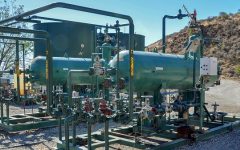
Oil rigs in the sunset. (Photo: Thaiview/Shutterstock)
Ringside: The Crossroads of Kern County
Until California can stop burning fossil fuel, that fuel ought to be sourced here in California
By Edward Ring, May 24, 2024 2:45 am
 With chronic uncertainty over water allocations for farm irrigation, and relentless and escalating regulatory assaults on its oil industry, the biggest economic sectors of Kern County are threatened. The irony is thick. Food and fuel are the prerequisites for civilization – the enabling foundation for California’s entire much broader and often spectacular economy – and yet the state government and its agencies are doing nothing to help. In most cases, their actions appear to be overtly hostile to the success of Kern County’s agriculture and energy industries.
With chronic uncertainty over water allocations for farm irrigation, and relentless and escalating regulatory assaults on its oil industry, the biggest economic sectors of Kern County are threatened. The irony is thick. Food and fuel are the prerequisites for civilization – the enabling foundation for California’s entire much broader and often spectacular economy – and yet the state government and its agencies are doing nothing to help. In most cases, their actions appear to be overtly hostile to the success of Kern County’s agriculture and energy industries.
To cover this situation, a staff writer for Grist.org has written an in-depth, 6,000 word report, published May 15, 2024, that tells the story of Taft, California, a town in Kern County that has, like so many others, been economically devastated by policies coming down from Sacramento. The author’s bias is revealed in the title: “Inside a California oil town’s divisive plan to survive the energy transition.” And again in the subtitle: “Kern County is betting on carbon capture to replace oil jobs and tax revenue. But will the county’s new economy repeat the sins of the old one?”
“Divisive.” “Sins.” Those are not adjectives to use lightly. But on one point we may all agree: Kern County is at a crossroads.
Here are two questions for the author of the Grist article to consider, along with any serious journalist. These are also questions to ask anyone in Kern County who is in a position to influence the policies and investments that will determine their future.
1 – When California still derives 50 percent of its total energy from petroleum products, why should California shut down its own oil industry via “a new wave of environmental lawsuits and an oil permitting pause instituted by Governor Gavin Newsom,” merely so California can import 70 percent of its oil and the petrochemical industry can divert their new investments to North Dakota and Texas?
2 – Isn’t California well positioned economically and technologically, and couldn’t California be highly motivated to develop and demonstrate clean methods of extraction and refining, instead of exporting the environmental impact to states and nations that are far less committed to clean energy technologies?
Further on in the Grist article, the author points out how Kern County’s leaders have embraced, or “pivoted” to “climate action” by supporting a plan to sequester millions of tons of CO2 in depleted oil wells to “prevent greenhouse gasses from wreaking havoc on the atmosphere.”
The problem, unsurprisingly, is that CO2 sequestration can’t occur unless there are ongoing activities involving combustion of fossil fuel. For climate action activists, that’s still unacceptable. “Net Zero” is not enough. It has to be zero. Lawsuits and regulatory attacks will continue as long as anything involving oil and gas is still combusting, anywhere. It won’t matter if the emissions are reprocessed into productive uses, or sequestered underground.
Kern County’s political and business leaders have several options. They can present scientific, peer reviewed evidence that CO2 is not harming the planet. That’s a tough choice even for those who believe it to be the truth. For an individual it risks professional suicide. For a region, it invites further alienation and regulatory harassment.
A safer strategy would be to argue that until California can stop burning fossil fuel, that fuel ought to be sourced here in California. That’s reasonable, but it’s a tough one to make if you’ve already conceded that burning fossil fuel is causing a “climate crisis.”
Or they can argue that it’s ok to burn fossil fuel if it can be safely sequestered underground. That approach has the best chance of attracting a critical mass of political support.
And so it would explain the enthusiasm for, as the Grist writer reports, a company in Kern County that is committed to growing its “carbon management business.” As noted in the article, “The company has already signed deals to store carbon for a hydrogen plant, a dimethyl ether plant, and a ‘renewable gasoline’ plant, all in the works near Elk Hills.” The article offers additional specifics, stating “There are two types of carbon capture: ‘point-source’ capture, which involves sucking up carbon-filled air directly from pipes and smokestacks before they release it into the atmosphere, and ‘direct air capture,’ a newer process that uses high-energy fans to extract carbon dioxide from ambient air.”
Here’s another question – and answer – that adds some clarity to a discussion as to which of these “two types of carbon capture” ought to be a priority:
How much CO2 is in the emissions from a natural gas fueled powerplant, and by comparison, how much CO2 is in the atmosphere?
As it is, atmospheric CO2 is 450 parts per million – that’s 4.5 one-hundredths of one percent. Power plant emissions, by contrast, are 45,000 parts per million, or 4.5 percent. There is 100 times as much CO2 available to extract from flue gas than there is from the air we breathe.
And here is where crossroads become paradoxes. Extracting CO2 from the atmosphere is unlikely to attract the same level of activist opposition, and these projects might be equally successful in attracting government subsidies. But it’s a ridiculous idea, because there’s hardly any CO2 in the atmosphere. That may be heretical to state openly, but it’s a fact, and it’s a fact that precludes any reasonable energy or financial payback. So do you take the subsidies, create jobs, possibly advance the technology, but basically accomplish nothing?
The harder, more “divisive” path politically makes far more sense from a financial and engineering perspective. Process flue gas where your feedstock is 4.5 percent CO2, because that extraction process is far more cost effective and doesn’t require nearly as much energy to extract per unit of captured CO2. But to do that, you have to take on the activists. You have to burn fossil fuel, for example by keeping natural gas power plants operating.
And then there’s the question of what to do with all that captured CO2. There’s plenty of underground capacity, but there are also a growing number of ways to utilize it as a product.
An approach for Kern County that would be true to California’s innovative spirit would be to become a hub for research and development of all emerging energy technologies. And in so doing, investors would have to balance the temptations offered by billions in federal subsidies with the long-term commercial prospects of the various projects once the subsidies have dried up and the hype has dissipated.
The potential to turn CO2 into a clean liquid fuel by blending it with hydrogen is just one of many research opportunities that Kern County is prepositioned with existing infrastructure to pursue. The motivation is there and the opportunity is there. But in their rush to appease the activists and attract the subsidies, they shouldn’t turn their backs on the industry that made them. That’s oil, and California still can’t live without it, whether we want to or not.
- Ringside: What is the Future of California’s Republican Party? - December 31, 2025
- Ringside: CA GOP Just Blew $46 Million for Nothing – Here’s How They Can Avoid Repeating That Mistake in 2026 - December 24, 2025
- Ringside: Will the Delta Pumps Operate at Capacity this Winter? - December 18, 2025





We’re carbon based lifeforms and can’t survive without it so whether extracting carbon via ‘point-source’ capture or ‘direct air capture’ is pure insanity? Only a demented satanic globalist would propose this nonsense?